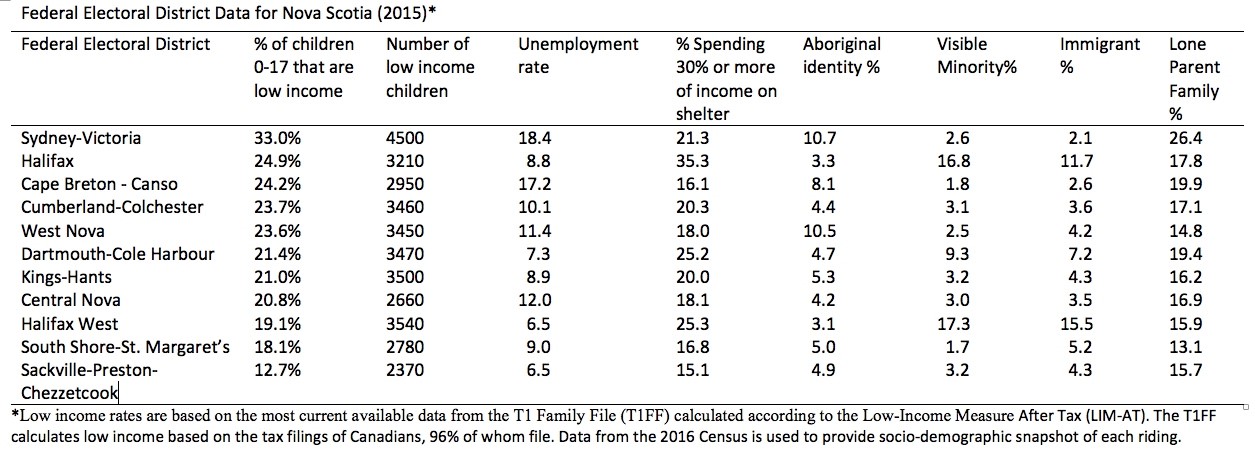By Lesley Frank
Next week marks the end of the school year and for some families the end of supports that are only available to their children in school, including breakfast. Families should have access to family-centred income and services provided without stigma for all. To reduce poverty requires leadership from all levels of government.
The Canadian government is soon to release its first Federal Poverty Reduction Strategy (PRS). As anti-poverty advocates and researchers we are excited, and not going to lie, nervous. We have been calling for Federal leadership to make good on the 1989 promise for nearly two decades in our annual provincial Child and Family Poverty Report Cards released in collaboration with Campaign 2000.
In 1989 the Canadian House of Commons passed an all-party resolution to end child poverty by the year 2000. That year came and went. Then after that, another generation of broken promises. The child poverty rate in Nova Scotia is 19.3% higher than it was in 1989. Now more than 1 in 5 children are living in families that are classified as low-income.
We are on the eve of an opportunity to get things right for the next generation of Canadian children. Will the PRS go far enough? Will we see a new social contract built on dignity and equity for the 1.2 million children in poverty in Canada, of which 35,890 lived in NS (in 2015 the last year for which we have data)?
Nova Scotia’s capacity to fund social programs largely depends on cost sharing arrangements with the Federal government. We require a strong strategy to correct the damage of years of austerity and the weakening of the social safety net. This federal strategy is especially important for Nova Scotia because:
- It has the highest rate of child poverty in Atlantic Canada.
- 5 of its 11 federal ridings are in the highest quintile of child poverty rates in the country
- 4 of its 11 federal ridings are in the second highest.
- 10 out of 11 of its federal ridings have child poverty rates above the national average of 17.4%.
- The province’s federal ridings with the highest levels of child poverty have higher percentages of unemployment, shelter insecurity, lone parent families, and Aboriginal people.

The Sydney-Victoria riding has the highest rate of child poverty (33%) in NS. In fact, this rate is the 10th highest rate of all 338 Federal Ridings in Canada. 2016 Census data shows that compared to other NS ridings, the Sydney-Victoria riding has the highest unemployment rate (18.4%), contains the highest percentage of those indicating Aboriginal identity (including the highest percentage of First Nations at 8.6%), and the highest percentage of lone parent families (26.4%).
The Halifax riding has the second highest rate of child poverty (24.9%) in Nova Scotia. 35.3% of household in the Halifax riding spend 30% or more of their income on shelter costs, and this riding has the second highest rate (16.8%) of visible minorities (including 4.4% Black Nova Scotians).
Federal ridings with the lowest child poverty rate are located outside the urban core of Halifax, but within the Halifax Regional Municipality, namely Sackville-Preston-Cheezecook (12.7%) and Halifax West (19.1%), and in the South Shore (18.1%).
71.5% of the children living in low-income circumstances live in ridings classified as rural (defined as those with population density of 150 persons per square kilometre or less). It is important to note that riding aggregates can hide inequities within ridings, as they contain communities with both high and low rates of child poverty. For example, while the Sackville-Preston-Cheezecook riding has the lowest child poverty rate in the province, the postal areas of North and East Preston have child poverty rates of 40% and 38.9% respectfully.
The data show the extent of the broken promise to end child poverty and the urgency to renew our social contract in Canada. If the Federal PRS takes up the recommendations of Campaign 2000 , we can expect to see:
- A commitment to legislate bold and achievable targets and timelines for poverty reduction
- A strong focus on the eradication of poverty for Indigenous peoples
- Stabilized and adequate transfer payments to provinces
- Stronger income security programs for everyone
- Improved support for workers including better Employment Insurance coverage and rates
- Funding for Universal and high quality Early Learning and Child Care
- Housing for all
- Mechanisms for levelling the playing field for marginalized people
- Universal drug and dental coverage
Lesley Frank is Research Associate for CCPA-NS, and Associate Professor, Sociology, Acadia University






